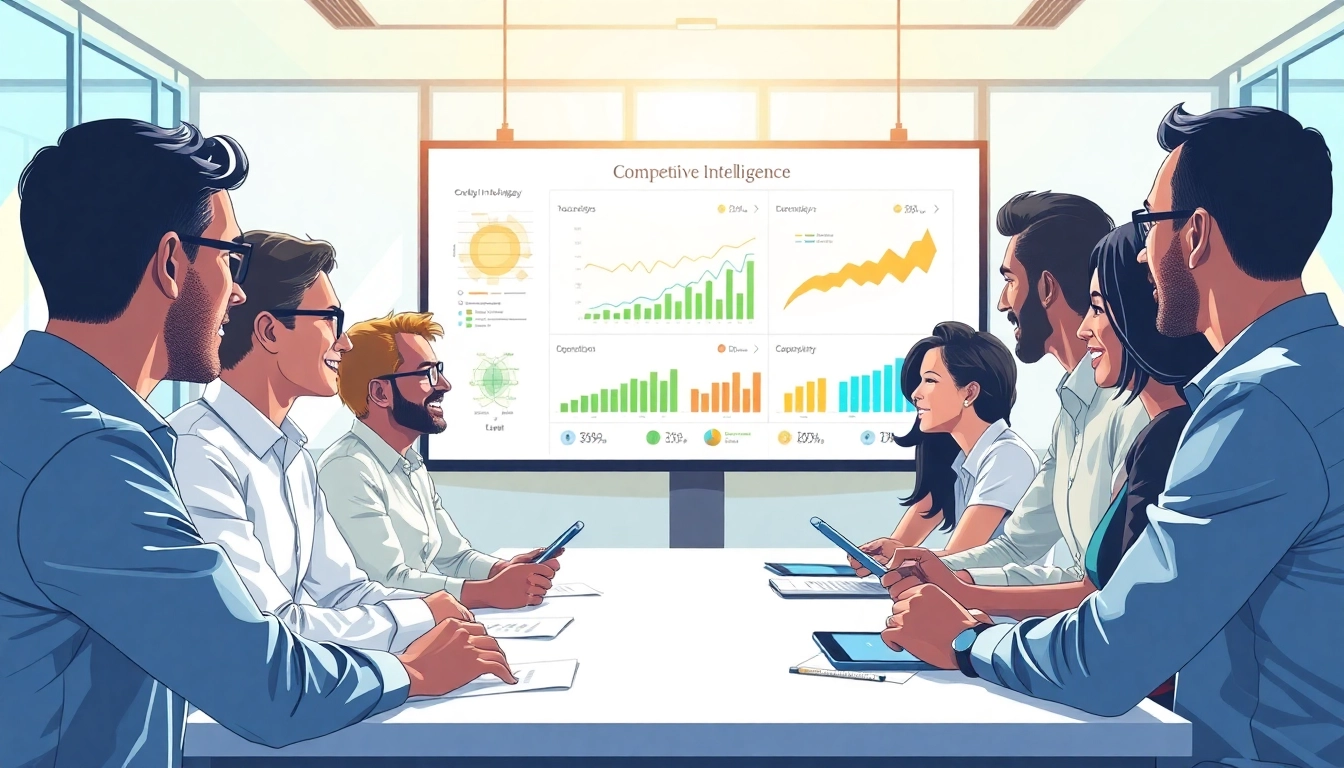Understanding AI Prompts for Competitive Intelligence
In today’s fast-paced business environment, leveraging ai prompts for competitive intelligence has become essential for companies seeking to gain an edge over their competitors. As organizations increasingly rely on technology to inform their decision-making processes, understanding how AI can be utilized for competitive analysis is crucial. This article delves into the intricacies of AI prompts, their significance in competitive intelligence, and how they can enhance your strategic initiatives.
What Are AI Prompts?
AI prompts are specific inputs that guide artificial intelligence tools to generate output relevant to a particular need or inquiry. These tools, often based on natural language processing, can process and analyze vast amounts of data, providing insights that would be labor-intensive and time-consuming if conducted manually. AI prompts can range from simple questions to complex statements designed to elicit detailed responses and analysis. By strategically crafting these prompts, businesses can extract useful competitive intelligence that helps clarify market dynamics, competitors’ strategies, and emerging trends.
The Importance of Competitive Intelligence
Competitive intelligence (CI) is the systematic gathering and analysis of information about competitors, market trends, and industry developments. It provides businesses with insights necessary for strategic decision-making, enabling them to anticipate changes and react proactively. CI offers several advantages:
- Identifying Market Opportunities: Understanding competitors’ strengths and weaknesses helps firms identify gaps in the market that they can exploit.
- Enhancing Strategic Planning: With accurate data on competitor strategies, businesses can develop more effective marketing and operational plans.
- Risk Management: Knowledge of industry trends and competitive movements allows organizations to mitigate risks more effectively.
- Improving Innovation: By assessing competitors’ product offerings, companies can enhance their innovation strategies and product development cycles.
How AI Enhances Competitive Analysis
AI enhances competitive analysis by automating data collection, processing vast datasets, and generating actionable insights. Here are several ways AI elevates this process:
- Data Aggregation: AI can systematically gather information from numerous sources such as news articles, social media, financial reports, and industry publications.
- Sentiment Analysis: By analyzing customer feedback and social media conversations, AI can gauge public sentiment regarding competitors, offering insights into their brand perception.
- Trend Identification: Through pattern recognition algorithms, AI tools can identify emerging trends that may affect market dynamics, allowing companies to adapt their strategies accordingly.
- Predictive Analytics: Machine learning models can forecast competitive movements and market shifts, giving businesses a strategic advantage in their planning processes.
Crafting Effective AI Prompts
To maximize the effectiveness of AI in competitive intelligence, crafting well-defined prompts is essential. The quality of your output is only as good as the quality of your input.
Key Elements of Effective Prompts
When constructing AI prompts, consider the following elements:
- Clarity: Your prompts should be straightforward and specific, directing the AI towards the information you seek.
- Context: Providing context in your prompts can lead to more relevant results. Include details that help the AI understand what you are analyzing.
- Relevance: Ensure that the prompts align with your business goals and the competitive intelligence you wish to acquire.
- Instruction: If the AI allows for custom instructions, clearly articulate what you want it to do with the gathered data.
Examples of AI Prompts for Competitive Intelligence
Here are some practical examples of AI prompts that can help draw valuable competitive intelligence:
- Market Assessment: “Analyze the three primary competitors in the tech industry, focusing on their product features, pricing strategies, and customer feedback.”
- SWOT Analysis: “Generate a SWOT analysis for [Competitor Name], including insights into their current market position and strategic initiatives.”
- Brand Sentiment: “What is the public sentiment toward [Competitor Name] based on recent social media discussions and reviews?”
- Trend Analysis: “Identify emerging trends in the [specific industry] based on recent reports and expert insights.”
Common Pitfalls to Avoid
While crafting your AI prompts, there are certain pitfalls to be aware of:
- Overly Complex Prompts: Avoid making your prompts too intricate, as this can confuse the AI and yield less relevant information.
- Lack of Relevance: Ensure that your prompts focus on current competitive landscapes to obtain actionable insights.
- Neglecting Output Validation: Always review the output generated by AI; inaccuracies or biases may affect your decisions.
Implementing AI Prompts in Your Strategy
Incorporating AI prompts into your competitive intelligence strategy involves several key steps to ensure successful implementation and utilization.
Steps to Integrate AI Prompts
Follow these steps to effectively integrate AI prompts into your competitive intelligence framework:
- Define Objectives: Clearly outline your competitive intelligence goals and what you hope to accomplish using AI prompts.
- Identify Tools: Research and select AI tools or platforms that suit your needs and expertise level.
- Design Prompts: Create a suite of prompts tailored to your competitive intelligence needs, using the principles described above.
- Test and Refine: Test your prompts in practice, measure their effectiveness, and adjust them based on results and feedback.
- Train Your Team: Ensure your team is trained on using these tools and prompts effectively, encouraging collaboration in interpreting the results.
Tools and Platforms to Use
A variety of AI tools can assist with competitive intelligence. Some popular platforms include:
- Crayon: This platform provides comprehensive competitive intelligence tools, enabling tracking of competitors’ movements and market changes.
- SEMrush: While predominantly an SEO tool, SEMrush offers functionalities to analyze competitors’ digital marketing strategies.
- BuzzSumo: BuzzSumo aids in analyzing content performance and brand sentiment across social media, allowing you to observe competitors’ engagements.
- Tableau: Utilize Tableau for data visualization; integrating AI-generated insights can enhance your reporting capabilities.
Measuring the Impact of AI Prompts
Once AI prompts are integrated, measuring their effectiveness is essential for continuous improvement. Here are some metrics to consider:
- Accuracy of Insights: Evaluate the relevance and accuracy of the information provided by the AI tool based on your objectives.
- Time Savings: Measure the time savings resulting from AI-assisted analysis compared to traditional manual methods.
- Decision Quality: Assess whether the insights gained from AI prompts have positively influenced decision-making processes and outcomes.
Case Studies: Successful Use of AI Prompts
Several companies have successfully implemented AI prompts in their competitive intelligence strategies, yielding significant benefits and insights.
Real-World Examples and Outcomes
Following are a couple of real-world examples that showcase the successful use of AI prompts in competitive intelligence:
- Example 1: A software startup utilized AI prompts to analyze customer sentiment and competitor product offerings. By refining their product based on the distilled insights, they managed to differentiate themselves effectively and increase their market share by 15% within one year.
- Example 2: A retail company implemented AI to conduct a thorough competitive analysis of pricing strategies. The insights gathered allowed management to recalibrate their pricing model, resulting in a 10% increase in sales over six months.
Lessons Learned from Implementation
From these case studies, critical lessons can be derived:
- Adaptability: Companies must be willing to adapt their strategies based on AI-generated insights continuously.
- Collaboration is Key: Involving cross-functional teams enhances the analysis quality and effectiveness of insights.
- Continuous Training: Regular workshops for team members on emerging AI tools can ensure ongoing empowerment and utilization of these technologies.
Best Practices from Industry Leaders
Industry leaders suggest several best practices when implementing AI prompts for competitive intelligence:
- Set Clear Metrics: Establish clear metrics for success, aligning results with business objectives.
- Innovate Regularly: Continuously update your prompts and AI tools as technology and market conditions change.
- Solicit Feedback: Regularly gather feedback from your team on the utility of insights from AI prompts to ensure relevance and effectiveness.
Future Trends in AI and Competitive Intelligence
As AI technology evolves, its application in competitive intelligence will continue to expand. Staying ahead in this area requires an understanding of emerging trends and innovations.
Emerging Technologies and Their Impact
Several emerging technologies are poised to influence competitive intelligence:
- Natural Language Processing (NLP): Advancements in NLP are improving AI’s ability to understand and analyze human language, enabling more sophisticated insights.
- Automated Reporting Tools: Future AI developments may simplify reporting processes, providing real-time dashboards populated with relevant data.
- Machine Learning: Enhanced algorithms will improve predictive analytics, allowing businesses to anticipate competitors’ movements with higher accuracy.
Predictions for AI in Competitive Analysis
Looking ahead, we can expect AI to become increasingly integrated into competitive intelligence practices:
- Greater Personalization: Tools will provide more tailored insights based on nuanced prompts and specific business contexts.
- Proactivity Over Reactivity: Rather than merely reacting to competitors, businesses will leverage predictive insights to navigate market challenges preemptively.
- Enhanced Collaboration: Future tools may also facilitate better collaboration between departments, streamlining communication regarding competitive strategies.
How to Stay Ahead in Competitive Intelligence
To maintain a competitive edge, businesses should adopt several strategies:
- Invest in Training: Regularly invest in employee training regarding AI technologies and competitive analysis best practices.
- Stay Updated: Keep abreast of new technologies and tools entering the market to maintain a competitive advantage.
- Engage with Experts: Collaborating with AI professionals or attending industry conferences can provide fresh insights and innovative approaches to competitive intelligence.














Leave a Reply